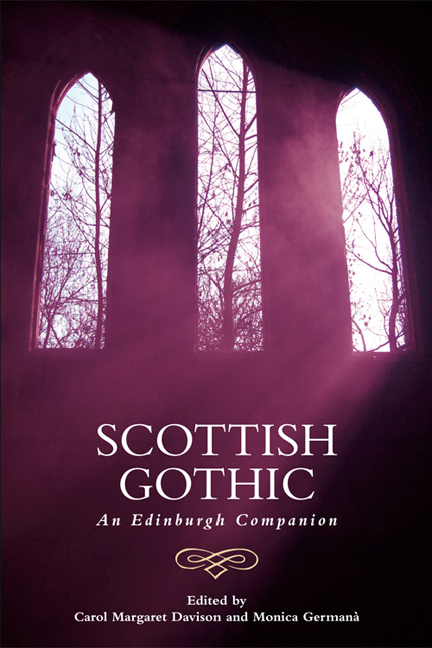Book contents
- Frontmatter
- Contents
- Acknowledgements
- 1 Borderlands of Identity and the Aesthetics of Disjuncture: An Introduction to Scottish Gothic
- 2 ‘The Celtic Century’ and the Genesis of Scottish Gothic
- 3 The Politics and Poetics of the ‘Scottish Gothic’ from Ossian to Otranto and Beyond
- 4 Robert Burns and the Scottish Bawdy Politic
- 5 Scottish Gothic Drama
- 6 Scottish Gothic Poetry
- 7 Calvinist and Covenanter Gothic
- 8 Gothic Scott
- 9 Gothic Hogg
- 10 ‘The Singular Wrought Out into the Strange and Mystical’: Blackwood's Edinburgh Magazine and the Transformation of Terror
- 11 Gothic Stevenson
- 12 J. M. Barrie's Gothic: Ghosts, Fairy Tales and Lost Children
- 13 The ‘nouveau frisson’: Muriel Spark's Gothic Fiction
- 14 Scottish Gothic and the Moving Image: A Tale of Two Traditions
- 15 New Frankensteins; or, the Body Politic
- 16 Queer Scottish Gothic
- 17 Authorship, ‘Ghost-filled’ Islands and the Haunting Feminine: Contemporary Scottish Female Gothic
- Notes on Contributors
- Index
15 - New Frankensteins; or, the Body Politic
Published online by Cambridge University Press: 20 December 2017
- Frontmatter
- Contents
- Acknowledgements
- 1 Borderlands of Identity and the Aesthetics of Disjuncture: An Introduction to Scottish Gothic
- 2 ‘The Celtic Century’ and the Genesis of Scottish Gothic
- 3 The Politics and Poetics of the ‘Scottish Gothic’ from Ossian to Otranto and Beyond
- 4 Robert Burns and the Scottish Bawdy Politic
- 5 Scottish Gothic Drama
- 6 Scottish Gothic Poetry
- 7 Calvinist and Covenanter Gothic
- 8 Gothic Scott
- 9 Gothic Hogg
- 10 ‘The Singular Wrought Out into the Strange and Mystical’: Blackwood's Edinburgh Magazine and the Transformation of Terror
- 11 Gothic Stevenson
- 12 J. M. Barrie's Gothic: Ghosts, Fairy Tales and Lost Children
- 13 The ‘nouveau frisson’: Muriel Spark's Gothic Fiction
- 14 Scottish Gothic and the Moving Image: A Tale of Two Traditions
- 15 New Frankensteins; or, the Body Politic
- 16 Queer Scottish Gothic
- 17 Authorship, ‘Ghost-filled’ Islands and the Haunting Feminine: Contemporary Scottish Female Gothic
- Notes on Contributors
- Index
Summary
In the introduction to his 2001 anthology of ‘New Scottish Gothic Fiction’, Alan Bissett argues that Gothic ‘has always acted as a way of re-examining the past, and the past is the place where Scotland, a country obsessed with re-examining itself, can view itself whole, vibrant, mythic’ (2001: 6). While virtually every contemporary Scottish author has made use of Gothic elements or tropes in some part of their work, many of the most important recent texts to be labelled ‘Scottish Gothic’ are centrally concerned with such a re-examination of the past. For many authors, however, the past is not to be found in historical events or cultural contexts, but specifically in the interrelation between established Scottish and Gothic literary traditions. Beginning with Emma Tennant's The Bad Sister (1978), one of numerous twentieth-century reworkings of James Hogg's The Private Memoirs and Confessions of a Justified Sinner (1824), many contemporary Gothic novels have explicitly relied on earlier texts; adapting the work of Hogg, Stevenson or even Shelley becomes a way of challenging preconceived notions of stable national and individual identities. While critics including David Punter have argued that any contemporary conception of ‘Scottish Gothic’ must ‘remain under a certain erasure’ lest the criticism develop an essentialist paradigm in contrast to both a modern global marketplace and the emergent recognition of Gothic as an international form (Punter 1999: 103), many of the novels themselves replace such categorical anxieties with a focus on the interpretative possibilities suggested by a return to tradition. More precisely, revisiting literary tradition allows for a focus on the text as a body, and the body as a text: in the novels discussed below, human bodies are both formed by, and read as, texts, suggesting that national and literary traditions are best approached not as abstractions, but in individual instances of embodiment. Whether looking to the past or the future, and whether writing in an explicitly Gothic mode or incorporating Gothic tropes within other genres, each of these novels problematises the relation between the embodied self and larger discourses of identity.
- Type
- Chapter
- Information
- Scottish GothicAn Edinburgh Companion, pp. 195 - 207Publisher: Edinburgh University PressPrint publication year: 2017



